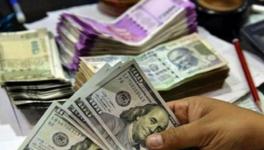Why World Economy is Facing Stagnation

Representational Image. Image Courtesy: Rawpixel
The fact that the world economy has slowed down since the financial crisis of 2008 is beyond dispute. In fact, even conservative American economists have started using the term “secular stagnation” to describe the current situation (though they have their own peculiar definition for it). The purpose of the present note is to give some growth-rate figures to establish this particular point.
Calculations of GDP (gross domestic product), which are notoriously unreliable for particular countries, are even more so for the world as a whole. In India, many researchers have questioned the official estimates of the growth rate of GDP, and have suggested that this rate can scarcely be above 4-4.5% per annum over the past several years in contrast to the 7% or so shown by official statistics.
The exultation over the acceleration of GDP growth in the neo-liberal period, compared with the dirigiste period, would appear to be entirely misplaced. And if the growth rate of GDP has scarcely increased compared with earlier, while inequalities have widened significantly, then the assertion that the condition of the working people has deteriorated in the neo-liberal period, as is clearly shown by other indicators, such as nutritional intake figures, would be even more firmly established.
But notwithstanding the utter shakiness of GDP data, let us examine what has been happening to world GDP.
For this purpose, let’s use World Bank data, with “real” GDP being estimated at 2015 prices for each country and aggregated for the world as a whole in terms of dollars at the 2015 exchange rates. The division of the entire period since 1961 into sub-periods and comparison across these sub-periods is quite tricky. Taking decadal growth rates is problematical, for, if the beginning of the decade happens to be a trough year, then the growth rate for the decade would get exaggerated, and hence give a distorted picture.
As far as possible, we have taken peak years and calculated the peak-to-peak growth rates of the world economy, which certainly gives a more reliable picture of the secular change in the growth rate. The specific years are 1961, 1973, 1984, 1997, 2007, and 2018, which was the last peak year before the pandemic set in. The growth- rates of world GDP during the sub-periods defined by these years are as follows:
Period GDP Growth Rate
(Per Year)
1961-1973: 5.4%
1973-1984: 2.9%
1984-1997: 3.1%
1997-2007: 3.5%
2007-2018: 2.7%
Source: World Bank data
Three conclusions stand out from these figures. First, the growth rate of the world economy during the dirigiste period was much higher than during the neo-liberal period as a whole. This is a point often overlooked in the standard discussion where the harping on the theme of the “superiority of the market” gives the impression that the world economy must have grown faster in the neo-liberal era. This impression, however, is completely false. Indeed, the exact opposite is the case, namely, a remarkable slowing down of the world economy in the period of neo-liberalism.
Second, between the dirigiste period and the neo-liberal period, there was an intervening period when there was a slowdown: the growth rate dropped from 5.4% to 2.9%. This slowdown was a consequence of the capitalist strategy to combat the acceleration of inflation that had occurred in the late 1960s and the early 1970s in the capitalist world and it marked the end of the dirigiste period.
It is this intervening period of a slowing down of world GDP growth that created the setting for the introduction of the neo-liberal regime. Finance capital that had been increasing in size and growing increasingly international had been pressing for a shift to neo-liberalism. But this pressure finally bore fruit because of the crisis of dirigisme that was manifested first in an inflationary upsurge and then as a slowing down of growth, as official policy all across the capitalist world sought to fight inflation by reducing government expenditure and creating mass unemployment.
Third, the figures show that a prolonged slowdown under neo-liberalism has followed the collapse of the housing bubble in the United States. This collapse precipitated a financial crisis in the capitalist world; but while the financial system was rescued through State intervention (so much for the “efficiency of the market”), the real economy has not seen any stimulus, in the form either of larger State expenditure or of a new bubble comparable to the housing one, to revive its growth rate.
We have deliberately taken 2018 as our terminal year, which represents a peak year. The period after 2018 has been even more dismal for the world economy. In fact, the GDP growth rate between 2018 and 2022, the latest year for which we have figures, has been a meagre 2.1% per annum.
World population figures again are not very reliable, with India itself not carrying out its decennial Census either in 2021 when it was due, or even subsequently; but the usual estimate is that it has been growing at a rate that is just short of 1% (it is estimated to be 0.8% in 2022). World per capita income, it would follow, is growing at just over 1% per annum at present.
Given the fact that income inequality in the world has been increasing, the overwhelming majority of the world’s population must have witnessed a virtual stagnation in their real incomes on average. An illustrative example will make this point clear. It is estimated that the top 10% of the world’s population receives at present more than half of the world’s total income. It follows that if the income of this top 10% grew by even 2% per annum, then the income of the remaining 90% would have remained absolutely stagnant on average.
The conclusion is inescapable that the capitalist system in its latest neo-liberal phase has brought the overwhelming mass of the world’s population to a state of income stagnation, on average, that is reminiscent of the colonial times; for vast numbers of people in the world there must have been a decline in real incomes.
What is more, this is not just some transient phenomenon that will disappear over time. This is what neo-liberalism has in store for them. A revival of growth in the present juncture would require an increase in aggregate demand in the world economy, which in turn would require the agency of the State; and the State can succeed in increasing demand only if it finances its larger expenditure either through a larger fiscal deficit or through larger taxation of the capitalists and, generally, of the rich.
But both these ways of financing larger State expenditure are frowned upon by international finance capital; and since the State is a Nation-State, while finance is globalised and can leave a country en masse at the drop of a hat, the State must kow-tow to the dictates of finance in order to prevent such a capital flight. Hence, State intervention by any particular Nation-State to boost aggregate demand and thereby increase the growth-rate of its economy is out of the question.
A coordinated fiscal stimulus, where several States simultaneously increase expenditure through either of the above-mentioned means, which might prevent finance from fleeing this entire group of countries, has not even been mooted. This leaves monetary policy as the only means of intervention available to the State.
Even here however a country’s interest rate cannot be too low compared with what prevails in advanced countries, especially the US, for then finance would find that country “unattractive” and leave it en masse. It is only the US that has the capacity to autonomously lower its interest rates to whatever it considers appropriate for stimulating aggregate demand (which would then allow other countries too to lower their interest rates). But the interest rates in the US for much of the recent period were close to zero and still there was no revival of the world economy. On the contrary, such low interest rates maintained over a long period had the effect of emboldening corporates in that country to raise their profit mark-ups and give rise to an acceleration of inflation, as has occurred of late.
Economist John Maynard Keynes’ lifelong project of stabilising capitalism at a high level of activity so that it is not overtaken by a socialist revolution, has thus turned out to be a chimera. The current state of neo-liberal capitalism amply demonstrates this fact.
Get the latest reports & analysis with people's perspective on Protests, movements & deep analytical videos, discussions of the current affairs in your Telegram app. Subscribe to NewsClick's Telegram channel & get Real-Time updates on stories, as they get published on our website.
























